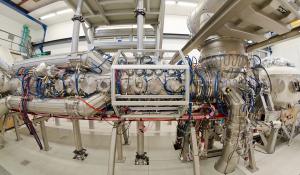First plasma beam on Magnum PSI
4 Nov 2011
-
Gieljan de Vries, FOM Institute for Plasma Physics Rijnhuizen
The 15-metre-long Magnum-PSI experiment in Rijnhuizen. A cascade arc plasma source (far left) produces plasmas of hydrogen, deuterium or argon. The vertical tubes guide lasers that determine the temperature and density of the plasma. The plasma beam impinges on the target plate (centre); a movable arm can then retract the target into a vacuum chamber for materials research without exposure to contamination in the air. (The magnets which focus the plasma into a beam were not installed at the time of this picture.) Photo: Bram Lamers
On 4 October, the new experiment for testing ITER-relevant plasma surface interactions—the Magnum-PSI facility at the Dutch FOM Institute for Plasma Physics Rijnhuizen—produced its first magnetized plasma beam.
When Magnum-PSI reaches its full design specifications, it will be the first laboratory facility capable of producing a continuous source of hot ionized gas (plasma) with plasma density and temperature very close to those expected in the ITER divertor region and under similar conditions of magnetic field strength and divertor target geometry.
The experiment already deposits a power of 8 MW per square metre on the beam target, close to the 10 MW per square metre steady-state load expected on the ITER divertor. Research on Magnum-PSI will open up new possibilities to put materials to the test in a plasma environment and for a length of time close to that expected in a fusion reactor.
Magnum-PSI was designed specifically to investigate the interaction between a fusion plasma and the components lining the walls of the reactor vessel (see related story here). In a fusion reactor, the divertor is a critical component; it acts as the principal surface intercepting the enormous energy carried by particles leaving the plasma core, it removes the reaction product—helium—from the reactor and it prevents contaminants resulting from plasma-surface interactions from streaming back into the high purity core.
Even though the plasma temperature in the divertor region will be as much as 10,000 times lower than that needed in the hot core, it will still be in the range of several tens of thousands of degrees Celsius and, when combined with the enormous fluxes of particles arriving at the targets, can potentially lead to severe erosion of target material if not properly controlled.
Magnum PSI uses a novel cascaded-arc plasma source to produce a hot, dense plasma from gas via an electric discharge between three cathodes and an anode; this plasma then flows towards a target located downstream and is confined into an intense, large area beam by a strong magnetic field, similar in strength to that ITER will use. The experiment also has an extensive suite of diagnostics to analyze the plasma itself (Thomson scattering and optical emission spectroscopy) and the target surface (laser-induced desorption, ablation and breakdown spectroscopy) during and after exposure Pedro Zeijlmans van Emmichoven leads the PSI Operations group which designed and built Magnum-PSI, and which is now commissioning the experiment. "Density, intensity, temperature, magnetic field—they're all in the ITER-relevant regime. We're setting a new record here! The plasma conditions we can achieve thanks to the use of the cascaded arc plasma source are up to two orders of magnitude more intense than in other existing laboratory facilities."
Magnum-PSI aims to shed light on the interaction between the plasma and the divertor targets in ITER, and in this way contribute to the development of strategies to increase the lifetime of components intercepting the ITER plasma. The Rijnhuizen institute will investigate damage of wall materials, determine how the plasma responds to impurities caused by eroded wall material, investigate where the eroded material is re-deposited, and study the retention of hydrogenic fuel in the wall.
Rijnhuizen Director Richard van de Sanden is very proud of the milestone achieved in producing the first magnetized plasma. He now looks forward to the research phase: "Nobody ever saw what happens to a reactor wall under such intense conditions. With Magnum-PSI, we can investigate this in a laboratory for the first time."
After producing its first magnetized plasma, Magnum-PSI is now being conditioned for scientific operations. Plasma-wall interaction experiments will start in early 2012. In the future, the facility will be upgraded with a superconducting magnet at higher field strength than produced by the copper magnets in these first experiments. The result will be a device permitting the investigation of truly long-term effects in the interplay between a fusion plasma and the vessel wall armour.
Special thanks go to Pedro Zeijlmans van Emmichoven and Greg De Temmerman from Magnum-PSI and Richard Pitts, Senior Scientific Officer in the ITER Plasma Wall Interations Section, for their contributions to this article.


